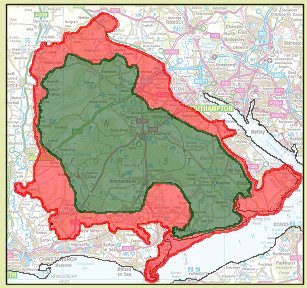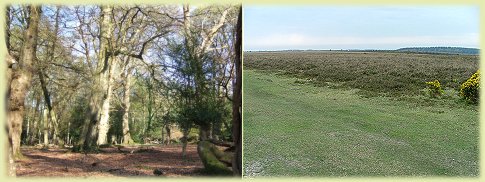What is the New Forest
What is
the New Forest
Overview
Understanding what the New Forest is, how it came to be and why the now National Park is such an important part of southern England’s heritage will help you get more out of your visit to the area, and hopefully give you a healthier respect and admiration for this part of Hampshire.
Essentially, the New Forest is an area on the very south-central coast of England, covering approximately 150 square miles.
The 1964 New Forest Act defined the perambulation of the Forest, a term used to describe the official area boundary and land enclosed within. The picture below shows the New Forest perambulation (green), compared to today’s National Park (red):
This mixture of habitat within the New Forest has led to much of the present day National Park area gaining Special Area of Conservation and Special Protected Area status under European Directives, and it’s now seen as a very important area for wildlife throughout Europe and one of the most important in the British Isles.
But the New Forest as we know it today exists solely because it was designated a royal hunting ground by King William I in the year 1079AD, as were certain other areas within the British Isles.
However, the word ‘forest‘ in this context doesn’t follow the usual meaning of the word. Instead, it was the term used to describe an area of land purchased under law (‘afforested’) for use by the Crown, in this case King William I.
When the New Forest was created in 1079, it immediately fell under very strict Norman Forest Laws, put into place to protect the natural wildlife of the area – not just the animals (notably deer and wild boar) but also the vegetation that they fed upon. These laws ensured a plentiful supply of fresh meat to the Crown, as well as offering good sporting opportunities within the designated area for the King and his noblemen to partake.
The unjustly harsh laws were aimed at the local peasants of the New Forest, or ‘commoners‘, and they prohibited anyone from interfering in any way with the natural lives of wild animals and their feeding habits. Specifically, commoners were not allowed to fence their properties to keep their own animals (ponies, cattle and pigs) from wandering off, because fences could impede the free running deer and boar.
In return for abiding by these laws the commoners were permitted certain rights, including the right to graze their animals on the Open Forest.
This particular law and the associated grazing rights had a huge influence over shaping the New Forest, and these basic rights still exist today, albeit in a somewhat more civilised form!
Commercial activities have of course also played a large part in shaping the New Forest into what it is today.
The planting and felling of trees for shipbuilding purposes by the Navy in past centuries, and now modern day commercial logging practices, are both important examples. It’s this commercial side of the New Forest that has been, and still is, responsible for the majority of the wooded inclosures throughout the area.
As an end result of all this human activity over time, the New Forest contains a rare mixture of habitats. The most notable habitat is the open heathland, large expanses of sandy land covered in heather and low scrub. Within many of the heathlands can be found small areas of wetland, or bogs.
Woodland areas make up the remainder of the New Forest, with a mixture of deciduous and coniferous forests. The oldest trees are the oak trees – some are thought to be between 300 and 400 years old!
The original native New Forest woodlands are referred to as Ancient and Ornamental Woodlands and the mixture of these, the heathlands and the bogs is collectively known as the Open Forest.
Above, two very contrasting but equally important New Forest habitats
The remainder of the New Forest area is made up of the Enclosures (Statutory & Verderers) where trees are managed for commercial logging purposes. And of course there is a percentage of the Forest land that is privately owned; that which is not is still owned by the Crown.
This very rare mixture of habitat which is the New Forest provides an excellent opportunity for nature and scientific studies, and this has been recognised by way of the New Forest receiving several major ‘scientific status’ positions; the recognition is not just within the UK but Europe as well.
The New Forest National Park, taking in some additional 70 square miles of land around the original New Forest perambulation, was created in March 2005 in further recognition of the importance of this unique area, to ensure the safe and secure future that the area deserves.
The New Forest Museum & Visitor Centre is the place to visit to learn more about the Forest.


